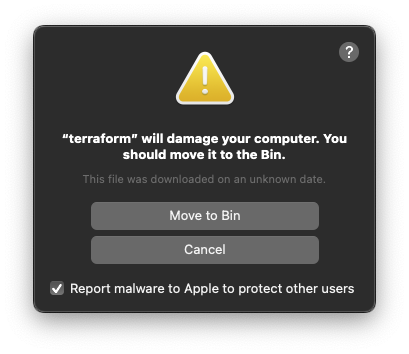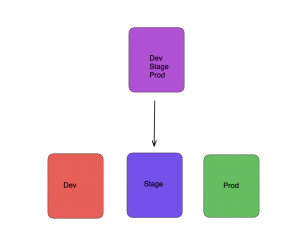Terraform Will Damage Your Computer
Introduction:
Terraform is a powerful open-source infrastructure as code (IaC) tool used for provisioning, managing, and automating infrastructure resources. While Terraform offers significant advantages, it is essential to recognize that its resource-intensive nature can potentially have adverse effects on your computer. In this article, we will delve deep into the potential risks associated with Terraform and discuss ways to mitigate and prevent any potential damage to your computer.
Understanding the Concept of Terraform:
Terraform enables users to define and provision infrastructure resources using declarative configuration files. It facilitates the creation and management of resources across various cloud providers, reducing manual configurations and increasing efficiency. However, this comprehensive management comes at a cost, as Terraform’s automatic provisioning capabilities necessitate a substantial amount of system resources.
Resource-Intensive Nature of Terraform:
Implementing Terraform involves high CPU and memory usage due to its comprehensive infrastructure provisioning process. This intense resource consumption can overload your computer and potentially cause performance degradation, leading to slower response times and decreased productivity.
Increased CPU and Memory Usage:
Terraform’s ability to provision resources across different cloud providers requires significant processing power. It utilizes the CPU to interact with API endpoints, validate configurations, and track resource states. Consequently, this increased CPU usage can strain your computer, potentially causing it to overheat and impacting its lifespan.
Potential Risks of Overheating Your Computer:
When a computer runs resource-intensive tasks like Terraform for prolonged periods, it generates excess heat. This excessive heat can lead to thermal throttling, sudden shutdowns, and even hardware damages. Proper ventilation, regular cleaning of dust buildup, and monitoring your computer’s temperature can help mitigate the risk of overheating.
Impact of Disk Space Utilization:
Another potential risk associated with Terraform is the utilization of significant disk space to store infrastructure configurations and resource states. As project complexity increases, so does the size of these files. Insufficient disk space can disrupt Terraform operations and overall system performance. Regularly monitor and manage disk space to mitigate this risk.
Possible Strain on Network Bandwidth:
Using Terraform requires frequent communication with cloud providers’ APIs to fetch and configure infrastructure resources. This continuous traffic can consume a considerable amount of network bandwidth, affecting other network-related applications. Prioritize your network’s resources and allocate adequate bandwidth to ensure a smooth experience.
Compatibility Issues with Existing Software and Hardware:
While Terraform is highly compatible with various cloud providers, it can introduce conflicts with existing software and hardware configurations on your computer. Ensure that you thoroughly assess compatibility requirements before utilizing Terraform to prevent potential disruptions to critical systems.
Potential for Conflicts with Other Programs:
Terraform’s resource-intensive nature can lead to conflicts with other programs running simultaneously. Sharing system resources can result in reduced performance, crashes, and instability. Regularly monitor system performance and adjust resource allocations to prevent conflicts and ensure a stable computing environment.
Importance of Monitoring System Performance:
To identify potential issues arising from Terraform’s resource-intensive operations, monitoring system performance is crucial. Utilize monitoring tools to track CPU and memory utilization, disk space, network bandwidth, and temperature. Regularly reviewing system performance can help detect any abnormalities and take proactive measures to protect your computer.
Mitigating Risks and Implementing Preventive Measures:
To mitigate the potential risks associated with Terraform, it is essential to implement preventive measures. Firstly, ensure that your computer meets the recommended hardware specifications for running Terraform effectively. Optimize system resources, allocate more memory or CPU power if necessary, and plan resource provisioning judiciously. Regularly clean your computer to prevent overheating, and maintain adequate disk space for smooth operations. Stay updated with the latest versions of Terraform and relevant software to avoid compatibility issues.
FAQs:
Q1. Will using Terraform damage my computer?
A1. While Terraform’s resource-intensive nature can strain your computer, following preventive measures and implementing adequate resource allocation can help mitigate any potential damage.
Q2. How can I prevent my computer from overheating when using Terraform?
A2. Ensure proper computer ventilation, regularly clean dust buildup, monitor temperature levels, and use cooling pads or fans if necessary.
Q3. Can Terraform cause conflicts with other software?
A3. Yes, Terraform’s resource consumption can cause conflicts with other programs running simultaneously. Monitor system performance and adjust resource allocations to prevent conflicts.
Q4. How much disk space does Terraform require?
A4. The amount of disk space Terraform utilizes depends on the complexity and scale of your infrastructure. Regularly monitor and manage disk space to prevent disruptions.
“Terraform” Will Damage Your Computer Mac Malware Removal Guide
Can Terraform Damage Your Computer?
Terraform is an open-source infrastructure-as-code software that allows users to build, deploy, and manage cloud infrastructure. It has gained popularity among developers and system administrators due to its simplicity and flexibility. However, as with any software, there may be concerns regarding its impact on a computer’s performance and security. In this article, we will explore whether Terraform can damage your computer and provide a comprehensive understanding of the risks involved.
Understanding Terraform’s Functionality
Before delving into any potential damage that Terraform may cause, let’s first understand how it works. Terraform operates by employing configuration files to define infrastructure resources within various cloud providers. These configuration files, written in Hashicorp Configuration Language (HCL), specify the desired state of the infrastructure. Terraform manages the deployment and ongoing maintenance of these resources, ensuring that they match the desired state specified in the configuration files.
Terraform’s Design Principles
One of Terraform’s fundamental design principles is that it should be idempotent, meaning that running the same configuration file multiple times should have the same effect as running it only once. This ensures that any changes made by Terraform to the infrastructure are predictable and reproducible. Therefore, by design, Terraform should not perform actions that could damage a computer, as it operates within the boundaries of the desired state specified in the configuration files.
Risks Associated with Terraform
While Terraform itself poses minimal risks to computer systems, some actions performed by Terraform can indirectly impact your computer’s security and performance. These risks are typically associated with misconfigurations or unauthorized access to Terraform files and infrastructure. Here are some potential risks to consider:
1. Misconfigured Infrastructure: If the Terraform configuration files contain incorrect or flawed instructions, it can lead to unintended actions or misconfigured infrastructure. These misconfigurations can have consequences ranging from service disruptions to unintended data exposure. It is crucial, therefore, to carefully review and validate your configuration files before deploying infrastructure.
2. Insecure Secrets Management: Terraform requires authentication tokens, access keys, and other sensitive information to interact with cloud providers and provision resources. If these sensitive credentials are not adequately protected and accidentally leaked or compromised, it can potentially allow unauthorized access to your infrastructure or cloud accounts.
3. Resource Exhaustion: Terraform can provision extensive infrastructure resources, such as virtual machines, databases, and storage. If these resources are not adequately managed or monitored, they can consume excessive computational and storage resources, potentially impacting your computer’s performance.
4. Unauthorized Access and Privilege Escalation: Any compromise or unauthorized access to Terraform’s infrastructure control plane can have severe consequences. Attackers may attempt to modify or destroy the infrastructure, leading to service disruptions or data breaches. Therefore, securing access to Terraform’s infrastructure and implementing stringent identity and access management practices is crucial.
Frequently Asked Questions (FAQs):
Q1. Can Terraform harm my computer’s hardware?
A: No, Terraform is software that operates at the infrastructure level and does not have direct control over your computer’s hardware. It cannot cause physical damage to your machine.
Q2. Can Terraform delete files on my computer?
A: Typically, Terraform provisions cloud infrastructure resources such as virtual machines, networks, and storage. It does not interact directly with files on your computer’s local disk. However, when dealing with cloud resources, there is a possibility that Terraform could delete or modify files stored within those resources. It is crucial to be cautious and understand the actions specified in your Terraform configuration files.
Q3. Can Terraform expose my sensitive data?
A: Terraform itself does not expose sensitive data. However, misconfigurations in your Terraform configuration files can inadvertently expose information, such as secrets, access keys, or network configurations. It is essential to follow recommended security practices, such as encrypting secrets, utilizing secure storage, and implementing proper access controls.
Q4. How can I protect my computer when using Terraform?
A: To protect your computer, consider the following best practices:
– Validate configuration files thoroughly before deploying infrastructure.
– Safeguard sensitive credentials and secrets, ensuring they are not accessible to unauthorized parties.
– Implement robust identity and access management practices to limit access to Terraform infrastructure.
– Regularly monitor and manage provisioned resources to prevent resource exhaustion and mitigate potential risks.
– Keep Terraform and its associated dependencies up to date by regularly updating to the latest versions.
In summary, while Terraform itself does not pose significant risks to your computer, it is crucial to be aware of potential vulnerabilities and mitigate them accordingly. By following best practices and understanding the risks associated with misconfigurations or unauthorized access, you can leverage Terraform’s power while ensuring the security and stability of your computer systems.
How To Install Terraform On Mac With Brew?
Terraform is an open-source infrastructure as code software tool that allows you to define and provision infrastructure resources across multiple cloud providers. With Terraform, you can easily manage your infrastructure as code, making it easier to automate infrastructure deployment and changes. In this article, we will guide you through the process of installing Terraform on a Mac using the brew package manager.
Step 1: Install Homebrew
To install Terraform with brew, you first need to have Homebrew installed on your Mac. Homebrew is a popular package manager for macOS that allows you to easily install and manage software packages. If you don’t have Homebrew installed, follow these steps to do so:
1. Open the Terminal on your Mac. You can find it in the Applications/Utilities folder, or you can search for it using Spotlight.
2. Once the Terminal is open, paste the following command and press Enter:
“`
/bin/bash -c “$(curl -fsSL https://raw.githubusercontent.com/Homebrew/install/HEAD/install.sh)”
“`
3. This command will start the installation process of Homebrew. You may be prompted to enter your password during the installation process.
4. Wait for the installation to complete. Once it’s finished, you can verify the installation by checking the version of Homebrew. Type the following command and press Enter:
“`
brew –version
“`
Step 2: Install Terraform
Now that you have Homebrew installed, you can proceed to install Terraform. Follow these steps:
1. Open the Terminal.
2. Use the brew command to install Terraform. Type the following command and press Enter:
“`
brew install terraform
“`
3. Homebrew will automatically download and install Terraform on your Mac. Wait for the installation process to complete.
4. To verify the installation, type the following command and press Enter:
“`
terraform –version
“`
You should see the version number of Terraform printed on the screen if the installation was successful.
FAQs:
Q1: What is Homebrew?
A1: Homebrew is a free and open-source package manager for macOS. It allows you to easily install, update, and manage various software packages and utilities on your Mac.
Q2: Why should I use Terraform?
A2: Terraform simplifies the process of managing infrastructure resources across different cloud providers. It allows you to define your infrastructure as code, making it easier to version control, automate, and provision infrastructure resources.
Q3: Can I use an alternative package manager instead of Homebrew?
A3: Yes, there are other package managers available for macOS, such as MacPorts and pkgsrc. However, this article focuses on using Homebrew as it is widely used and simplifies the process of installing and managing software packages.
Q4: Are there any prerequisites for installing Terraform with Homebrew?
A4: As long as you have a macOS system with Homebrew installed, there are no specific prerequisites for installing Terraform using the brew package manager.
Q5: How do I update Terraform to the latest version?
A5: If you already have Terraform installed via Homebrew, you can easily update it to the latest version by running the following command in the Terminal:
“`
brew upgrade terraform
“`
This command will update Terraform to the newest available version.
In conclusion, installing Terraform on a Mac using Homebrew is a straightforward process that allows you to easily manage your infrastructure as code. By following the steps outlined in this article, you can quickly set up Terraform and begin provisioning your infrastructure resources across multiple cloud providers. Happy coding!
Keywords searched by users: terraform will damage your computer
Categories: Top 60 Terraform Will Damage Your Computer
See more here: nhanvietluanvan.com
Images related to the topic terraform will damage your computer

Found 23 images related to terraform will damage your computer theme




![APP NAME] will damage your computer. You should move it to the Trash.' Removal Report App Name] Will Damage Your Computer. You Should Move It To The Trash.' Removal Report](https://img.youtube.com/vi/z8DErpgQcpw/hqdefault.jpg)





Article link: terraform will damage your computer.
Learn more about the topic terraform will damage your computer.
- Terraform will damage your computer on macOS Intel
- [Solved] Terraform will damage your computer on Mac
- Terraform will damage your computer? | by Karif Battle – Medium
- [Solved] Terraform will damage your computer on Mac
- Install Terraform – HashiCorp Developer
- Manage Terraform Versions – HashiCorp Developer
- Hashicorp Terraform | endoflife.date
- “Terraform will damage your computer” Pop-Up
- “Terraform will damage your computer” Mac Malware Removal
- “terraform” will damage your computer – HashiCorp Discuss
- How to Remove Terraform will damage your computer pop-up …
- Remove “Terraform” will damage your computer Mac Malware
- Mac literally just started blocking terraform, popup window that …
- “terraform” will damage your computer. You should move it to …
See more: nhanvietluanvan.com/luat-hoc